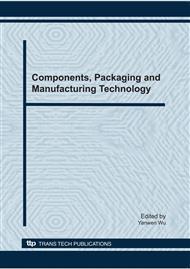[1]
S. Dˇzeroski, Multi-Relational Data Mining: An Introduction. ACM SIGKDD Explorations Newsletter, Vol. 5, Issue 1, pp.1-16, (2003).
DOI: 10.1145/959242.959245
Google Scholar
[2]
T. Seidl, H.P. Kriegel: Optimal Multi-step k-Nearest Neighbor Search, in: Proc. ACM SIGMOD International Conference on Management of Data, pp.154-165, (1998).
DOI: 10.1145/276305.276319
Google Scholar
[3]
P.S. Bradley, U.M. Fayyad: Refining Initial Points for K-Means Clustering, in: Proc. 15th International Conf. on Machine Learning, pp.91-99, (1998).
Google Scholar
[4]
T. Kohonen: Self Organization Maps. Springer-Verlag. New York. (2001).
Google Scholar
[5]
B. Georgescu, I. Shimshoni, P. Mee: Mean Shift Based Clustering in High Dimensions: A Texture Classification Example, in: Proc. of Inter. Conference on Computer Vision, pp.456-463, (2003).
DOI: 10.1109/iccv.2003.1238382
Google Scholar
[6]
E. Novak, K. Ritter: The Curse of Dimension and a Universal Method for Numerical Integration. Multivariate Approximation and Splines, (1998).
DOI: 10.1007/978-3-0348-8871-4_15
Google Scholar
[7]
A. Gionis, P. Indyk, R. Motwani: Similarity Search in High Dimensions via Hashing, in: Proc. of Inter. Conference on Very Large Data Bases, pp.518-529, (1999).
Google Scholar
[8]
D. Comaniciu, P. Meer: Mean shift: A robust approach toward feature space analysis. IEEE Transactions on pattern analysis and machine intelligence. Vol. 24, No. 5, pp.603-619, (2002).
DOI: 10.1109/34.1000236
Google Scholar
[9]
M. Datar, N Immorlica, P Indyk: Locality-sensitive hashing scheme based on p-stable distributions, in: Proc. of 20th annual symposium on Computational geometry, pp.253-262, (2004).
DOI: 10.1145/997817.997857
Google Scholar
[10]
A. Denmark: Near-Optimal Lower Bounds on the Multi-Party Communication Complexity of Set Disjointness, in: 18th Annual IEEE Conference on Computational Complexity, (2003).
DOI: 10.1109/ccc.2003.1214414
Google Scholar
[11]
R.R. Coifman, M.V. Wickerhauser: Entropy-based algorithms for best basis selection, IEEE Transactions on Information Theory, Vol. 38, No. 2, pp.713-718, (1992).
DOI: 10.1109/18.119732
Google Scholar
[12]
J.H. Friedman: Flexible Metric Nearest Neighbor Classification. Tech. Report, Dept. of Statistics, Stanford University, (1994).
Google Scholar
[13]
http: /www. uncc. edu/knowledgediscovery.
Google Scholar
[14]
T. Hastie, R. Tibshirani, Discriminant Adaptive Nearest Neighbor Classification. IEEE Trans. on Pattern Analysis and Machine Intelligence. Vol. 18(6), pp.607-615, (1996).
DOI: 10.1109/34.506411
Google Scholar
[15]
C. Domeniconi, J. Peng, D. Gunopulos: An Adaptive Metric Machine for Pattern Classification. Advances in Neural Information Processing Systems. Vol. 13. (2001).
Google Scholar
[16]
T. J. Hastie, R. J. Tibshirani, Classification by Pairwise Coupling, in: M. I. Jordan, M. J. Kearns (eds. ): Advances in Neural Information Processing Systems, Vol. 10, pp.507-513, (1998).
Google Scholar
[17]
R. Kohavi: A Study of Cross-Validation and Bootstrap for Accuracy Estimation and Model Selection, in: Proc. of IJCAI, pp.1137-1143, (1995).
Google Scholar
[18]
http: /www. cs. cmu. edu/afs/cs/project/theo-11/www/naive-bayes. html.
Google Scholar
[19]
R. Weber, H. Schek, and S. Blott: A quantitative analysis and performance study for similarity-search methods in high-dimensional spaces, in: Proc. 24th Inter Conference on Very Large Data Bases, pp.194-205, (1998).
Google Scholar
[20]
J.R. Quinlan: C4. 5: Programs for Machine Learning. Morgan-Kaufmann Publishers, (1993).
Google Scholar


